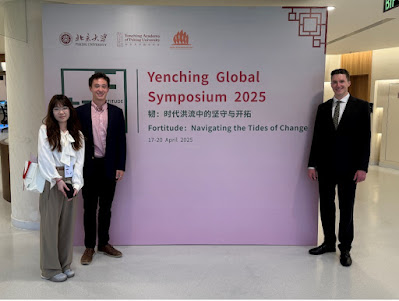Five-Semester Student Takes Conflict Management Studies Outside the Classroom
Many Five-Semester Option students choose to concentrate in China Studies during their three semesters in the MA program at SAIS in Washington, DC. A growing number, however, are focusing on other regions or areas of study to supplement the coursework taken during their year in the Certificate program at the Hopkins-Nanjing Center.
Kaelyn Lowmaster is a current Five-Semester Option student concentrating in both China Studies and Conflict Management. Read about her experience on the annual Conflict Management field research trip:
"There’s no better training ground for China hands than the Hopkins-Nanjing Center, so when I came to SAIS for the DC leg of my five-semester option program, I was excited to broaden my academic focus and apply what I learned in Nanjing to different regions and disciplines. I added a second concentration in Conflict Management to my primary one of China Studies, expecting to research China’s diplomatic behavior around the world. I could not have anticipated that my study of international negotiations would lead me to active conflict regions thousands of miles from both Nanjing and DC.
One of the great perks of the Conflict Management program is the annual field research trip. Each year, a few students have the opportunity to study regions experiencing active conflict firsthand over winter break. We meet people at all levels, from high-level officials to students, affected by protracted disputes. This year, fifteen of my classmates and I headed to the Caucasus to research the dispute over Nagorno-Karabakh (NK). A semester’s worth of briefings at SAIS had taught me the basics: NK was a majority ethnic Armenian enclave within the Azerbaijani SSR, when in 1988 it petitioned to be moved to the jurisdiction of the Armenian SSR. Tensions escalated into bloody pogroms, and eventually to all-out war after the collapse of the Soviet Union. The conflict has been 'frozen' since a cease-fire in 1994 – Armenia had won the war, but there continue to be a few dozen deaths a year along the line of contact. No one quite knows what might happen if widespread hostilities broke out once again, but there’s not much optimism about the current course of negotiations, either.
Each of us had picked a particular aspect of the conflict to study, and I decided that I’d look at the mediation process. Before landing in Baku, I’d read all the diplomatic jargon of the stalemate in the latest press releases (for a frustrating read, you can find them all here), and had thought I was ready to present a fresh perspective on how to move negotiations forward.
I wasn’t prepared for the overwhelmingly complex reality of the conflict on the ground, though. We started in Baku, Azerbaijan’s oil-soaked capital, where newly constructed flame-shaped skyscrapers dwarf the old city. There we heard of Armenia’s illegal occupation of NK and the surrounding territories, that international law is on the side of Azerbaijan, that Armenia is a Russian puppet state. After three days, we made our way to Armenia for the other side of the narrative. The drive from Baku to Yerevan, a geographical distance of only about 280 miles, takes about 12 hours to complete. Borders are closed, flights are grounded, and the only way from one to another takes a bus, two border crossings, and a brief swing through Georgia. In Armenia the refrain of distrust was familiar – that Azerbaijan’s oil wealth had made it warlike, that Armenia needs the territories surrounding NK to guarantee its security, and that ethnic Armenians in NK had a fundamental right to self-determination.
The only ray of optimism came from the refugee groups we met with on both sides. 'They were our neighbors…we just want to go home,' one Azerbaijani woman displaced from NK by the war told us. 'Tell them we want to live in peace.' On the last day of our trip, an Armenian mother who had lost her son and nephews in the war told us to bring her message to the mothers of Azerbaijan, 'that we understand their pain.'
In international relations, it’s easy to view problems in abstract terms, looking for tradeoffs that can be made or theoretical strategies that can be applied. But sitting in a one-room apartment that housed nine refugees the day after meeting with the foreign minister of Armenia has a way of changing one’s perspective. For the first time I was faced with the very human responsibility of negotiators, something that’s often lost in high-level deal-making. I hope that, at some level, our trip to the region will eventually have some small positive impact on the peace process, but in the meantime it definitely made each of us better students of conflict management."
Kaelyn Lowmaster is a current Five-Semester Option student concentrating in both China Studies and Conflict Management. Read about her experience on the annual Conflict Management field research trip:
 |
| Kaelyn in Baku |
One of the great perks of the Conflict Management program is the annual field research trip. Each year, a few students have the opportunity to study regions experiencing active conflict firsthand over winter break. We meet people at all levels, from high-level officials to students, affected by protracted disputes. This year, fifteen of my classmates and I headed to the Caucasus to research the dispute over Nagorno-Karabakh (NK). A semester’s worth of briefings at SAIS had taught me the basics: NK was a majority ethnic Armenian enclave within the Azerbaijani SSR, when in 1988 it petitioned to be moved to the jurisdiction of the Armenian SSR. Tensions escalated into bloody pogroms, and eventually to all-out war after the collapse of the Soviet Union. The conflict has been 'frozen' since a cease-fire in 1994 – Armenia had won the war, but there continue to be a few dozen deaths a year along the line of contact. No one quite knows what might happen if widespread hostilities broke out once again, but there’s not much optimism about the current course of negotiations, either.
Each of us had picked a particular aspect of the conflict to study, and I decided that I’d look at the mediation process. Before landing in Baku, I’d read all the diplomatic jargon of the stalemate in the latest press releases (for a frustrating read, you can find them all here), and had thought I was ready to present a fresh perspective on how to move negotiations forward.
 |
| Old City Baku with the newly-constructed flame towers |
 |
| The view into Nagorno-Karabakh from the Armenian side |
 |
| Iconic statue of a Karabakhi man and woman |


